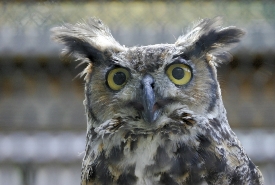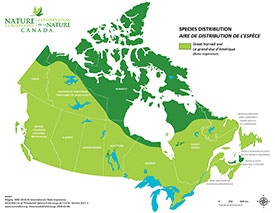
Great horned owl (Photo by Bill Hubick)
Great horned owl
What does the great horned owl look like?
The great horned owl, the most common owl in the Americas, can be distinguished from other owl species by the lengthy, feathered tufts on its head, called “plumicorns.” It also has a speckled, grey-brown body, reddish-brown face and white patches on its throat.
Its wide, rounded wings help it manoeuvre through trees. It also has big, yellow eyes with pupils that open broadly in darkness. Although the great horned owl cannot move its eyes within its sockets, it is able to see in any direction because it can rotate its head 180 degrees.
Where is the great horned owl found?
The great horned owl is found throughout the Americas, ranging from the treeline to South America. Being the adaptable birds that they are, their habitats include deserts, wetlands, deciduous and coniferous forests, tropical rainforests, grasslands, tundra edges, orchards, parks, suburbs and cities. They have a wider range of nesting sites than any other North American bird. Most commonly, they reuse other birds’ nests in trees, but will also nest in tree cavities, cliff ledges and on the ground.
What does the great horned owl eat?
Of all the North American birds of prey, great horned owls have the most varied diet. They mainly feed on small- to medium-sized mammals and some birds, such as ducks and geese.
These raptors primarily hunt at night, but sometimes during the day. After a perched owl recognizes prey from a height, it will follow it while airborne and then grab it with its powerful talons. Occasionally, it will hunt for smaller prey, such as mice and insects, on foot. Once it has made its kill, it will swallow smaller prey in its entirety or rip larger prey into tinier pieces. It will then regurgitate pellets consisting of indigestible prey parts.
What is the great horned owl's conservation status?
Although great horned owls are classified as least concern, according to the International Union for the Conservation of Nature, the global population is estimated at 6 million, with 14 per cent living in Canada. The total population decreased by about 33 per cent between 1966 and 2015. Canadian populations have had even greater declines, with a loss of 72 per cent.
What is NCC doing to protect the great horned owl's habitat?
Great horned owls inhabit many NCC properties. In March 2015, NCC hosted a night-time owl survey event for Conservation Volunteers at the Makinak Woods property in Manitoba. The results of this survey, combined with those of previous surveys, helped determine how best to manage the NCC-owned properties inhabited by great horned owls, such as the Bunchberry Meadows and Warner Philip Conservation Areas.






